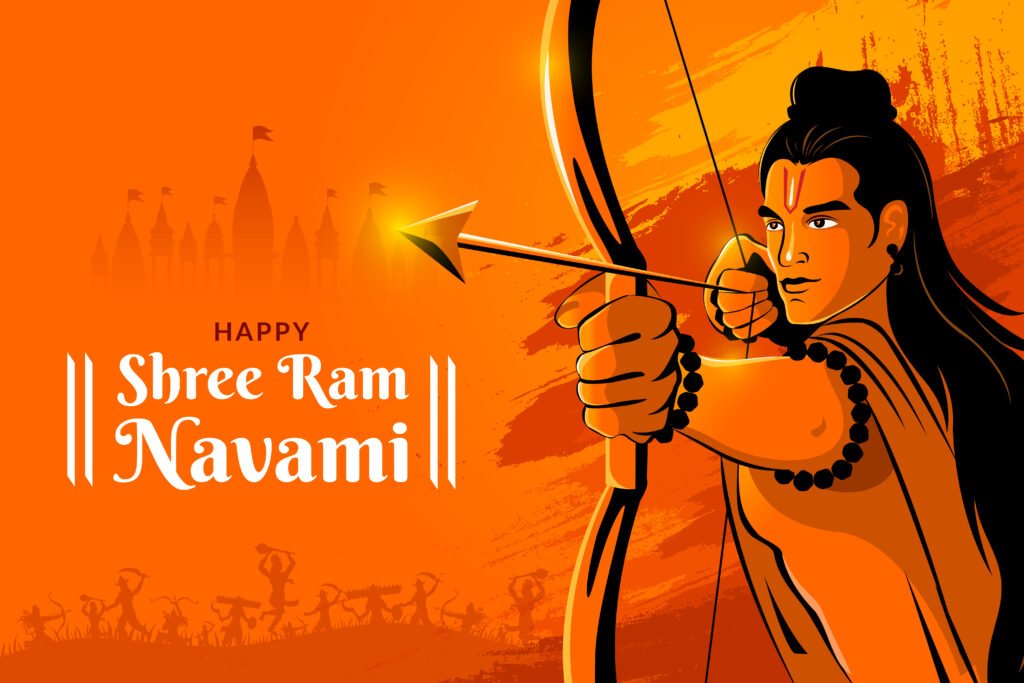
Origins of the Festival:
The birth of Lord Rama, a manifestation of Lord Vishnu, is commemorated at this festival. This event is observed on the ninth day of the first month in the Hindu calendar, which falls between March and April. As the future king of Ayodhya, Lord Rama was renowned for his admirable traits.
Religious Importance:
By that time, Rama’s exile had ended, and he, Sita, and Laxmana had returned to Ayodhya, where Rama had been proclaimed king. The meaning of Rama is related to the psychological metaphor in the Ramayana. Rama signifies pure consciousness, or the Divine Self.
Cultural Impact:
In Karnataka, Rama Navami is observed by local mandalis (organizations) and streets by giving away free panakam (a jaggery drink) and food. Furthermore, in Bengaluru, in the state of Karnataka, the Sree Ramaseva Mandali, R.C.T (R.) Chamrajpet, hosts India’s most prominent month-long classical music festival.
Significance of Ramnavami
Spiritual Lessons:
Lord Rama maintained self-control in his ideas, deeds, and emotions. He stayed composed and at ease in all situations, including those involving great provocation. Lord Rama had integrity. He kept his word and did not compromise on his ideals.
Community and Unity:
Ram Navami is celebrated by people of all faiths. It shows how it is a symbol of unity and harmony among different communities which is something Ram stood for.
Cultural Heritage:
This festival furnish us with an opportunity to exhibit our traditions, rituals, and convictions, thereby transmitting them to subsequent generations. Through the commemoration of festivals like Ram Navami, we guarantee that our cultural identity and principles remain preserved and revered, rather than fading into obscurity. This ensures that our heritage endures and flourishes, cherished and celebrated by future generations.
How is Ram Navami Celebrated?
Rituals and Traditions:
The nation celebrates Ram Navami, particularly at Ayodhya, North India, which is frequently thought to be the birthplace and residence of Lord Rama. Rama Katha recitals, or the narrating of stories, folklore, and myths about Lord Rama, including those found in The Ramayana itself, kick off the day. To commemorate the occasion, devotees also take part in kirtans and bhajans throughout the day. Furthermore, it is customary in the country’s northern regions to create small idols of Lord Rama as a newborn, dressing, bathing, and eventually placing him in cradles, just like a real baby. To pay their respects to Lord Rama, some people even fast or observe vratas throughout the day. In Ayodhya, many individuals bathe in the sacred river Sarayu before visiting the Rama shrine.
While South India does not celebrate Ram Navami with the same grandeur and display as the North, they do have their own traditions. Ratha yatras, or chariot processions, are frequently held in parts of Karnataka to pay honor to Lord Rama and his close family, including his wife Sita, faithful brother Lakshmana, and devotee Hanuman. They also provide free panakam (a jaggery-based drink) to devotees and perform Carnatic music on the day in question.
Similarly, Tamil Nadu commemorates it by presenting water (jalam) to Lord Surya early in the morning to satisfy him.People think that Surya is Lord Rama’s immediate ancestor.
History of Ram Navami
Mythological Roots:
Rama is a key deity in Hinduism. He is Vishnu’s seventh avatar, and one of his most popular. In Rama-centric Hinduism, he is revered as the Supreme Being.
According to the Ramayana, Kausalya and Dasharatha gave birth to Rama at Ayodhya, the capital of the Kingdom of Kosala. His siblings were Lakshmana, Bharata, and Shatrughna. He married Sita. Born into a royal family, Rama’s childhood is characterized in Hindu literature as one marked by unexpected shifts, like an exile into poverty and terrible circumstances, as well as ethical obstacles and moral quandaries.
The complete life narrative of Rama, Sita, and their companions serves as an allegory for an individual’s obligations, rights, and communal responsibilities. It demonstrates dharma and dharmic living through a model.
Historical Evolution:
Ram Navami, which commemorates the birth of Lord Rama, has ancient origins extending back to the Vedic period. Its observance grew over millennia, attaining popularity during the Bhakti movement in medieval India, when devotion to Rama became widespread. During the Mughal Empire, the event was suppressed but continued underground. During the colonial period, it witnessed a renaissance spurred by Hindu reformers. Following independence, Ram Navami became a highly celebrated holiday in India, with elaborate marches, bhajan recitations, and temple rites. Today, it is still a significant religious and cultural holiday, with communities all over the world celebrating Rama’s birth with tremendous excitement.
Geographical Spread:
Several cities featured in the Ramayana traditions concerning Rama’s life hold big festivities. These include: Ayodhya (Uttar Pradesh), Rameswaram (Tamil Nadu), Bhadrachalam (Telangana), and Sitamarhi (Bihar).
The traditions and customs linked with Rama Navami differ by area across India.
In Karnataka, Rama Navami is observed by local mandalis (organizations) and roads by giving away free panakam (a jaggery drink) and food. Furthermore, in Bengaluru, Karnataka, the Sree Ramaseva Mandali, R.C.T (R.) Chamrajpet, hosts India’s most prominent month-long classical music festival. This 80-year-old musical spectacular is unique in that acclaimed Indian classical artists, regardless of religion, from both genres – Carnatic (South Indian) and Hindustani (North Indian) – descend to provide their musical renditions to Rama and the assembled audience.
In eastern Indian states such as Odisha, Jharkhand, and West Bengal, Jagannath temples and the local Vaishnava community celebrate Rama Navami at the start of their yearly Jagannath Ratha Yatra in summertime.
Devotees linked with ISKCON fast all day.In order to meet the requirements of the rising native Hindu congregation, a number of ISKCON temples began to celebrate the event more prominently. However, it was an important calendar event on the traditional Gaurabda calendar, with devotees being required to fast.
Insights from the Life of Lord Rama for Students
Role Model:
If we look at life of Lord Rama in the indian epic Ramayana, we can see how he followed his dharma which consists of righteousness, morality, and fulfilling duty. Through his actions he set a profound example of what it means to live a life of Dharma even in tough times.
Perseverance and Courage:
Rama’s life begins with a key act of commitment to truth and vows. When his father, King Dasharatha, is forced to fulfill a previous commitment to his wife, Kaikeyi, by sending Rama into exile and declaring her son Bharata as king, Rama accepts the decision without resentment. This episode not only demonstrates Rama’s reverence for his father, but also his strong devotion to Satya (truth) and maintaining one’s word.
Humility and Respect:
Have faith and passion for your job, not your position. Rama wanted to be king so that he could serve his father. So, as his father exiled him, Rama fulfilled his job.
Rama remained married and unwaveringly loyal to his sole wife, Sita. However, through patience and experience, he stuck true for his beliefs and remains India’s greatest ruler.
Ramayana tells us to have a noble purpose in life. If we have motivation, we can excite our minds to perform the work or pursue our dreams. Honesty should be a way of life and ought to show up in a person’s actions toward oneself, relatives, goals, community, customs, rituals, and practices.
Learning from Mistakes:
The first and most significant lesson of the Ramayana is the value of Dharma in a person’s life. Prabhu Shriram always led a really ethical life, carrying out his moral obligations and duties as the ideal son, spouse, and monarch.
Balancing Personal and Professional Life:
Rama’s quest is also a story about combining personal feelings with duty. This conflict is particularly visible in his interactions with Sita. Regardless of his feelings, Rama is obligated to make decisions as a king for the betterment of his people, demonstrating the often complex and challenging nature of Dharma, where responsibility to society can trump personal emotions. For more insights on similar topics, explore Chrysalis High. Delve into a wealth of resources tailored to enlighten and engage.
FAQs:
Did Ram get married on Ram Navami?
Hindus think that on Vivah Panchami Tithi in the Treta Yuga, Lord Ram and Mother Sita were wedded. Hence, on the Panchami Tithi of Shukla Paksha, which falls in the month of Margashirsha, Vivah Panchami Tithi is observed annually.
Why do we worship Durga on Ram Navami?
Rama became fearful of going to fight, so Brahma advised him to worship Durga, who would offer him courage. Under a bilva tree, Rama prayed to Durga and offered her sacrifice by reciting the Devi Sukta along with other Tantric songs.
What not to eat on Ram Navami?
It is advisable to stay away from non-vegetarian food. On this auspicious day, it is best to stay away from non-vegetarian cuisine. Consuming vegetarian cuisine is lucky and might help you attract good vibes into your life. Steer clear of alcohol and tobacco: It is not advised to smoke or drink during Ramnavmi.


